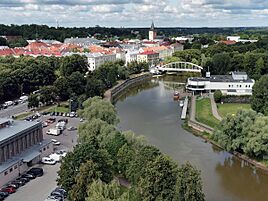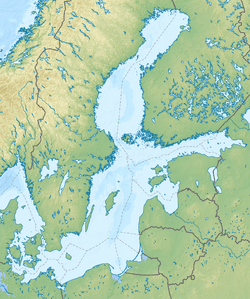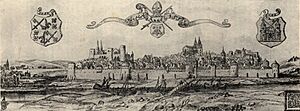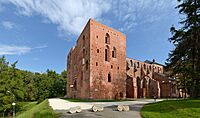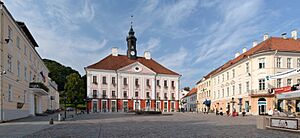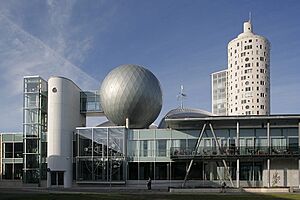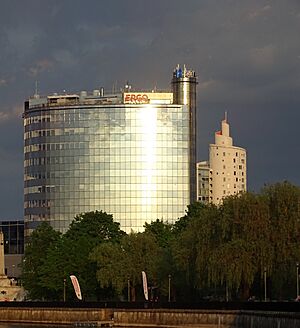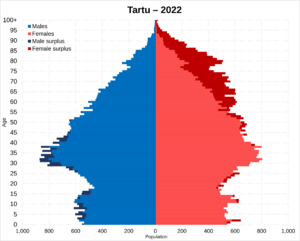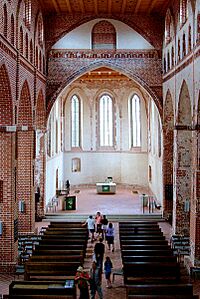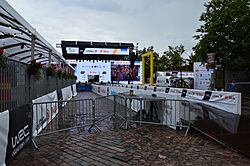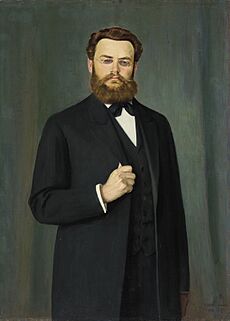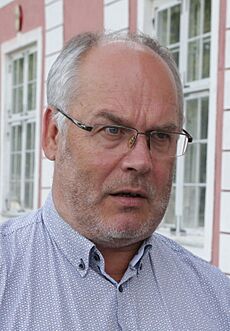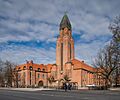Tartu facts for kids
Quick facts for kids
Tartu
|
|||||
|---|---|---|---|---|---|
|
City
|
|||||
| Tartu | |||||
|
From top: View of Tartu, Tartu old town, Estonian National Museum, University of Tartu, Town Hall Square
|
|||||
|
|||||
| Nickname(s):
Capital of Southern Estonia
|
|||||
| Motto(s):
Heade mõtete linn
("City of good thoughts") |
|||||
| Country | Estonia | ||||
| County | Tartu County | ||||
| Municipality | Tartu | ||||
| First settled | 5th century AD | ||||
| First mentioned | c. 1030 | ||||
| City rights | before 1262 | ||||
| Area | |||||
| • Total | 38.80 km2 (15 sq mi) | ||||
| • Land | 37.9 km2 (14.6 sq mi) | ||||
| • Water | 1.3 km2 (0.5 sq mi) 3.39% | ||||
| Elevation | 57.2 m (188 ft) | ||||
| Highest elevation | 79 m (259 ft) | ||||
| Population
(2023)
|
|||||
| • Total | 97,435 | ||||
| • Rank | 2nd | ||||
| • Density | 2,511.2/km2 (6,500/sq mi) | ||||
| GDP | |||||
| • City | €3.042 billion (2022) | ||||
| • Per capita | €30,569 (2022) | ||||
| Ethnicity | |||||
| • Estonians | 80.3% | ||||
| • Russians | 13.4% | ||||
| • other | 5.3% | ||||
| Time zone | UTC+02:00 (EET) | ||||
| • Summer (DST) | UTC+03:00 (EEST) | ||||
| Postal code |
50050 to 51111
|
||||
| Vehicle registration | T | ||||
| Website | City of Tartu | ||||
Tartu is the second largest city in Estonia, right after Tallinn. As of 2023, about 97,435 people live there. Tartu is located about 186 kilometers (116 miles) southeast of Tallinn. It's also 245 kilometers (152 miles) northeast of Riga, the capital of Latvia.
The city sits on the Emajõgi river, which connects Estonia's two biggest lakes: Lake Võrtsjärv and Lake Peipus. For many centuries, from the 1200s to the late 1800s, Tartu was known by its old name, Dorpat.
Tartu is the main city in southern Estonia. It's often called the "intellectual capital" of the country. This is because it's home to the oldest and most famous university in Estonia, the University of Tartu, which was founded in 1632. Tartu also has the Supreme Court of Estonia, the Ministry of Education and Research, the Estonian National Museum, and the oldest Estonian-language theater, Vanemuine. It's also where the famous Estonian Song Festivals began.
In 2024, Tartu was chosen as the European Capital of Culture.
Contents
Understanding Tartu's Name and History
The name Tartu might come from the word tarvas, which means aurochs (a type of wild ox). Since Estonia became an independent country in 1918, the Estonian name Tartu has been the official one. However, throughout history, the city has had different names in other languages. Most of these names come from the earliest known form, Tarbatu.
For example, in German, Swedish, and Polish, the city was often called Dorpat. In Russian, it was known as Yuryev (named after Prince Yaroslav I the Wise) and Derpt. In Latvian, it was called Tērbata, and in Finnish, Tartto.
The Emajõgi River, which flows through Tartu, means 'mother river' in Estonian. This shows how important the river has been to the city.
Early Beginnings of Tartu
People first settled in the area where Tartu is now as early as the 5th century AD. By the 7th century, local people had built a wooden fort on the east side of Toome Hill. Over time, this settlement grew and became a busy trading center around the 9th to 10th centuries.
The first written records about Tartu come from the early 11th century. Around 1030, Yaroslav I the Wise, a powerful prince from Kievan Rus', attacked the region. After winning a battle, he built his own fort there and called it Yuryev. This fort might have been under Kievan Rus' control until 1061. That year, the Yuryev fort was burned down by local tribes. The fort was rebuilt by the locals soon after.
In the 12th century, there were many fights between the local people and troops from the nearby Novgorod Republic. Tartu was captured temporarily in 1133 or 1134, and again in 1191–1192. However, these captures did not lead to lasting changes in who controlled the area.
Tartu as a Medieval Bishopric
In the early 13th century, during the Northern Crusades, the fort of Tarbatu was captured and recaptured many times. In 1224, after a long fight, the fort was finally taken by the Teutonic crusaders. After this, Tartu became known as Dorpat. It grew into an important trading city during the Middle Ages. It also became the capital of the Bishopric of Dorpat, which was a semi-independent state ruled by a bishop.
In 1262, an army led by Prince Dmitri of Pereslavl attacked Dorpat. They captured and destroyed the town, but they couldn't take the bishop's strong fortress on Toome Hill. This event was written down in old German and Slavic records. These records also mentioned that German merchants and craftspeople had started living near the bishop's fortress.
Later in medieval times, Dorpat became a key trading city. In the 1280s, it joined the Hanseatic League, a powerful group of trading cities in Northern Europe.
Polish-Lithuanian and Swedish Rule
In 1558, Ivan the Terrible, the Russian tsar, invaded Tartu. This started the Livonian War. The city surrendered after being heavily attacked. The local bishop was sent to prison in Moscow, which ended the city's self-rule. Tartu then became part of the Polish–Lithuanian Commonwealth in 1582. A Jesuit grammar school was opened in 1583. The city also received its red and white flag from the Polish king.
The school closed during the Polish–Swedish War. In 1600, Swedish forces tried to take the city but failed. However, in 1601, a captain switched sides and helped the Swedes enter. The Polish-Lithuanian Commonwealth took the city back in 1603.
In 1625, during another war, Tartu was captured by Sweden for good. In 1629, the city officially became part of Sweden. This led to the founding of the University of Tartu in 1632 by King Gustavus Adolphus of Sweden.
Tartu in Imperial Russia
In 1704, the Russian army, led by Tsar Peter the Great, captured Tartu. About a quarter of the town and many of its defenses were damaged. In 1708, the remaining defenses and houses were destroyed, and all citizens were sent to Russia. After the Treaty of Nystad in 1721, Tartu became part of the Russian Empire and was known as Derpt.
Fires in the 1700s destroyed much of the old buildings. The Great Fire of Tartu in 1775 burned down most of the city center. The city was rebuilt in a beautiful Late Baroque and Neoclassical style. The Tartu Town Hall was built during this time, between 1782 and 1789.
In the second half of the 19th century, Tartu became a very important cultural center for Estonians. It was a time of Romantic nationalism, where people celebrated their national identity. The first Estonian Song Festival was held in Tartu in 1869. Vanemuine, the first national theater, was started in 1870. The Society of Estonian Writers was also founded in Tartu in 1872.
The Tartu railway station opened in 1876, connecting Tartu by train. In 1893, the city was officially renamed Yuryev by the Russian government. From 1895, Russian became the main language for teaching at the university.
Independent Estonia (1918–1940)
After World War I, Estonia became independent, and the city was officially called Tartu. At the end of the Estonian War of Independence (1918–1920), a peace treaty was signed in Tartu on February 2, 1920. This was the Treaty of Tartu between Russia and Estonia. In this treaty, Russia agreed to give up its claims to Estonian land "for all time." Another peace treaty, between Russia and Finland, was also signed in Tartu in 1920.
During the years between the two World Wars, new areas like Tähtvere were built. The Estonian National Museum moved into the old Raadi Manor buildings. The art school Pallas also opened.
German and Soviet Occupations (1940–1991)
During World War II, the Soviet Union took over Estonia and Tartu in June 1940. Large parts of the city, including the historic Kivisild (Stone Bridge), were destroyed. This happened partly in 1941 by the retreating Soviet Army and almost completely in 1944 by the retreating German Army. Tartu was bombed many times by Soviet air forces in 1943 and 1944.
After the war, much of the city's old center was in ruins. The Soviet authorities even tore down less damaged buildings to create parks and parking lots. Tartu was declared a "closed town" for foreigners because a large airbase for bombers was built at Raadi Airfield. This airbase was one of the biggest military airbases in the former Eastern Bloc.
Tartu Airport opened in 1946. The Estonian Aviation Academy was established in 1993. The privately owned Estonian Aviation Museum opened in 2002. During the Soviet occupation (1944–1991), Tartu's population almost doubled. This was due to many people moving from Russia and other parts of the Soviet Union, partly because of the military airbase.
Modern Era in Tartu
Since Estonia became independent again in 1991, the old town center of Tartu has been rebuilt and improved. For example, St. John's Church, which was ruined during World War II, has been restored. Many new shops and business buildings have been built, such as Tartu Kaubamaja, Tasku, Emajõe kaubanduskeskus, Lõunakeskus, and Kvartal. The tallest residential building, Tigutorn, opened in 2008.
The AHHAA science center moved to a new building in 2011. The new main building of the Estonian National Museum opened in 2016.
Tartu's Geography and Climate
Climate in Tartu
Tartu has a humid continental climate. This means it has warm summers and cold winters. The climate is quite mild for its northern location, thanks to the nearby Baltic Sea and warm air from the Atlantic Ocean. However, sometimes in winter, temperatures can drop very low, even below -30°C, though this is rare.
The official weather station for Tartu is in Tõravere village, about 20 kilometers away. So, the actual temperature in the city itself might be a little warmer than the official averages.
| Climate data for Tartu (Tõravere) normals 1991–2020, extremes 1865–present | |||||||||||||
|---|---|---|---|---|---|---|---|---|---|---|---|---|---|
| Month | Jan | Feb | Mar | Apr | May | Jun | Jul | Aug | Sep | Oct | Nov | Dec | Year |
| Record high °C (°F) | 9.7 (49.5) |
10.9 (51.6) |
18.4 (65.1) |
27.5 (81.5) |
30.9 (87.6) |
34.0 (93.2) |
34.9 (94.8) |
35.2 (95.4) |
30.3 (86.5) |
21.5 (70.7) |
13.8 (56.8) |
13.0 (55.4) |
35.2 (95.4) |
| Mean daily maximum °C (°F) | −1.8 (28.8) |
−1.6 (29.1) |
3.3 (37.9) |
11.1 (52.0) |
17.1 (62.8) |
20.6 (69.1) |
23.1 (73.6) |
21.8 (71.2) |
16.3 (61.3) |
9.2 (48.6) |
3.3 (37.9) |
0.0 (32.0) |
10.2 (50.4) |
| Daily mean °C (°F) | −4.1 (24.6) |
−4.4 (24.1) |
−0.5 (31.1) |
5.9 (42.6) |
11.5 (52.7) |
15.5 (59.9) |
18.0 (64.4) |
16.7 (62.1) |
11.8 (53.2) |
6.0 (42.8) |
1.2 (34.2) |
−2.1 (28.2) |
6.3 (43.3) |
| Mean daily minimum °C (°F) | −6.5 (20.3) |
−7.3 (18.9) |
−4 (25) |
1.2 (34.2) |
5.8 (42.4) |
10.3 (50.5) |
12.9 (55.2) |
12.0 (53.6) |
8.0 (46.4) |
3.3 (37.9) |
−0.8 (30.6) |
−4.2 (24.4) |
2.6 (36.7) |
| Record low °C (°F) | −37.5 (−35.5) |
−36.0 (−32.8) |
−29.6 (−21.3) |
−19.8 (−3.6) |
−7.2 (19.0) |
−2.2 (28.0) |
1.8 (35.2) |
1.5 (34.7) |
−6.6 (20.1) |
−13.8 (7.2) |
−22.2 (−8.0) |
−38.6 (−37.5) |
−38.6 (−37.5) |
| Average precipitation mm (inches) | 48 (1.9) |
39 (1.5) |
36 (1.4) |
35 (1.4) |
54 (2.1) |
88 (3.5) |
67 (2.6) |
79 (3.1) |
55 (2.2) |
68 (2.7) |
55 (2.2) |
51 (2.0) |
673 (26.5) |
| Average precipitation days (≥ 1.0 mm) | 12.8 | 9.9 | 9.3 | 8.3 | 8.5 | 10.7 | 9.5 | 11.2 | 9.8 | 11.9 | 11.3 | 12.4 | 125.6 |
| Average relative humidity (%) | 88 | 85 | 76 | 68 | 65 | 70 | 74 | 77 | 82 | 86 | 89 | 89 | 79 |
| Average dew point °C (°F) | −7 (19) |
−8 (18) |
−4 (25) |
0 (32) |
6 (43) |
10 (50) |
13 (55) |
13 (55) |
9 (48) |
4 (39) |
1 (34) |
−3 (27) |
3 (37) |
| Mean monthly sunshine hours | 33.7 | 65.1 | 140.3 | 190.9 | 266.0 | 258.0 | 268.7 | 227.6 | 152.1 | 79.3 | 30.0 | 24.3 | 1,735.9 |
| Source 1: Estonian Weather Service | |||||||||||||
| Source 2: Time and Date (dewpoints, 2005-2015) | |||||||||||||
Tartu's Economy and Transport
Economy in Tartu
While Tartu is famous as a university town, it also has important industries. The food industry has always been a big part of the city's economy. Some major food companies here include A. Le Coq, Tartu Mill, and Salvest. Kroonpress is one of the top printing companies in the Baltic countries.
In the early 2000s, many ICT (Information and Communication Technologies) companies and other high-tech businesses started in Tartu. Examples include Playtech Estonia, Nortal, ZeroTurnaround, and Skype also has an office here. The University of Tartu is one of the largest employers. This means many highly skilled people, like researchers, professors, and doctors, work in Tartu. The Tartu University Clinic is also a very large employer.
Transport in Tartu
Tartu has its own airport, Tartu Airport. The city is well-connected to other places by bus and train. You can easily travel to Tallinn, Riga, and other Estonian towns from Tartu. For example, the distance to Pärnu, Estonia's "summer holiday capital," is about 176 kilometers (109 miles).
People and Neighborhoods of Tartu
Population and Ethnic Groups
Tartu's population has changed over time. Here's a look at how it has grown and the different ethnic groups living there.
| Year | 1881 | 1897 | 1922 | 1934 | 1959 | 1970 | 1979 | 1989 | 1995 | 2000 | 2005 | 2010 | 2015 | 2020 | 2021 |
|---|---|---|---|---|---|---|---|---|---|---|---|---|---|---|---|
| Population | 29,974 | 42,308 | 50,342 | 58,876 | 74,263 | 90,459 | 104,381 | 113,320 | 104,874 | 106,200 | 104,490 | 100,930 | 93,805 | 92,972 | 95,190 |
The table below shows the ethnic makeup of Tartu from 1922 to 2021. You can see how the percentages of Estonians, Russians, and other groups have changed over the years.
| Ethnicity | 1922 | 1934 | 1941 | 1959 | 1970 | 1979 | 1989 | 2000 | 2011 | 2021 | ||||||||||
|---|---|---|---|---|---|---|---|---|---|---|---|---|---|---|---|---|---|---|---|---|
| amount | % | amount | % | amount | % | amount | % | amount | % | amount | % | amount | % | amount | % | amount | % | amount | % | |
| Estonians | 42459 | 84.5 | 51559 | 87.6 | 44732 | 93.7 | 56205 | 75.7 | 68129 | 75.3 | 77597 | 74.3 | 82031 | 72.3 | 80397 | 79.5 | 79700 | 81.7 | 76227 | 80.1 |
| Russians | 2570 | 5.11 | 2640 | 4.48 | 1490 | 3.12 | - | - | 18009 | 19.9 | 21530 | 20.6 | 24604 | 21.7 | 16245 | 16.1 | 14340 | 14.7 | 12441 | 13.1 |
| Ukrainians | - | - | 16 | 0.03 | - | - | - | - | 1277 | 1.41 | 1685 | 1.61 | 2369 | 2.09 | 1239 | 1.22 | 891 | 0.91 | 1107 | 1.16 |
| Belarusians | - | - | - | - | - | - | - | - | 551 | 0.61 | 749 | 0.72 | 1088 | 0.96 | 490 | 0.48 | 355 | 0.36 | 304 | 0.32 |
| Finns | - | - | 49 | 0.08 | 27 | 0.06 | - | - | 1220 | 1.35 | 1271 | 1.22 | 1275 | 1.12 | 1073 | 1.06 | 706 | 0.72 | 900 | 0.95 |
| Jews | 1115 | 2.22 | 920 | 1.56 | 0 | 0.00 | - | - | 420 | 0.46 | 346 | 0.33 | 267 | 0.24 | 154 | 0.15 | 113 | 0.12 | 81 | 0.09 |
| Latvians | - | - | 278 | 0.47 | 1043 | 2.18 | - | - | 137 | 0.15 | 197 | 0.19 | 167 | 0.15 | 105 | 0.10 | 113 | 0.12 | 268 | 0.28 |
| Germans | 3210 | 6.39 | 2706 | 4.60 | - | - | - | - | - | - | 103 | 0.10 | 133 | 0.12 | 123 | 0.12 | 118 | 0.12 | 306 | 0.32 |
| Tatars | - | - | 6 | 0.01 | - | - | - | - | - | - | 112 | 0.11 | 146 | 0.13 | 83 | 0.08 | 65 | 0.07 | 45 | 0.05 |
| Poles | - | - | 144 | 0.24 | 71 | 0.15 | - | - | - | - | 164 | 0.16 | 179 | 0.16 | 159 | 0.14 | 92 | 0.09 | 133 | 0.14 |
| Lithuanians | - | - | 26 | 0.04 | 15 | 0.03 | - | - | 102 | 0.11 | 127 | 0.12 | 159 | 0.14 | 96 | 0.09 | 74 | 0.08 | 109 | 0.11 |
| unknown | 0 | 0.00 | 278 | 0.47 | 44 | 0.09 | 0 | 0.00 | 0 | 0.00 | 0 | 0.00 | 0 | 0.00 | 378 | 0.37 | 136 | 0.14 | 255 | 0.27 |
| other | 902 | 1.79 | 254 | 0.43 | 335 | 0.70 | 18058 | 24.3 | 614 | 0.68 | 500 | 0.48 | 1002 | 0.88 | 649 | 0.64 | 897 | 0.92 | 3014 | 3.17 |
| Total | 50256 | 100 | 58876 | 100 | 47757 | 100 | 74263 | 100 | 90459 | 100 | 104381 | 100 | 113420 | 100 | 101169 | 100 | 97600 | 100 | 95190 | 100 |
Religion in Tartu City (2021) [1] Unaffiliated (77.1%) Lutheran (10.2%) Orthodox & Old Believers (8.4%) Others Christians (2.1%) Others Religions or Unknown (2.0%)
Tartu's Neighborhoods
Tartu is divided into 17 official neighborhoods. These neighborhoods don't have their own governments, but their names and boundaries are set.
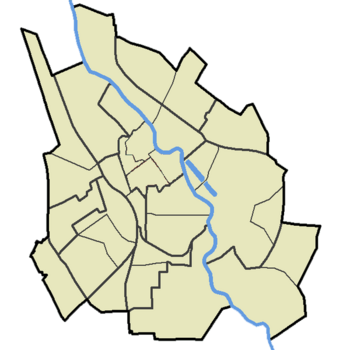
tööstusrajoon
Kruusamäe
Mõisa
| Neighborhood | Area (ha) | Residents 2001 | Residents 2006 | Residents 2012 |
|---|---|---|---|---|
| Annelinn | 541 | 30,000 | 28,200 | 27,480 |
| Ihaste | 424 | 1,000 | 1,800 | 2,322 |
| Jaamamõisa | 149 | 3,000 | 3,000 | 3,202 |
| Karlova | 230 | 9,500 | 9,000 | 9,073 |
| Kesklinn(Downtown) | 180 | 7,500 | 6,700 | 6,575 |
| Maarjamõisa | 113 | 800 | 500 | 377 |
| Raadi-Kruusamäe | 283 | 5,000 | 4,800 | 4,626 |
| Ropka | 146 | 5,500 | 5,300 | 5,120 |
| Ropka industrial district | 354 | 2,700 | 2,700 | 2,511 |
| Ränilinn | 122 | 2,500 | 1,800 | 1,732 |
| Supilinn | 48 | 2,100 | 1,800 | 1,790 |
| Tammelinn | 311 | 8,000 | 8,100 | 8,195 |
| Tähtvere | 250 | 4,500 | 3,500 | 3,023 |
| Vaksali | 75 | 2,900 | 3,100 | 3,206 |
| Variku | 77 | 2,000 | 1,900 | 1,840 |
| Veeriku | 281 | 5,500 | 5,300 | 5,561 |
| Ülejõe | 302 | 8,200 | 7,700 | 7,876 |
Education and Culture in Tartu
Tartu is most famous for being home to the University of Tartu. This university was founded in 1632 by King Gustavus Adolphus of Sweden. Because of its strong academic background, Tartu is sometimes playfully called "Athens of the Emajõgi" or the "Heidelberg of the North."
Tartu is also where you'll find the Estonian University of Life Sciences, the Baltic Defence College, and the Estonian Aviation Academy. The Estonian Ministry of Education and Research is also located here. Other important places include the Supreme Court of Estonia, the Estonian Historical Archives, the Estonian National Museum, and the Estonian Sports and Olympic Museum. The city also has the oldest and most respected theater in the country, Vanemuine, which has ballet, theater, opera, and musical shows.
In music, there's a special style called the Tartu school of composition. Many sculptures in Tartu honor historical figures. Famous ones include the Barclay de Tolly monument, the Kissing Students fountain, and Gustav II Adolf's monument.
Science and Research in Tartu
Tartu has been a center for learning and science in Estonia and the Baltic countries for hundreds of years. Many important scholars have come from Tartu. These include Karl Ernst von Baer, who was a pioneer in studying how living things develop. Another was Jakob von Uexküll, who was a pioneer in studying animal behavior. Juri Lotman was a famous cultural theorist.
Johann Friedrich von Eschscholtz, a doctor and naturalist, was born in Tartu. He explored the Pacific region and collected many plants and animals in places like Alaska, California, and Hawaii. Wilhelm Ostwald, who won the Nobel Chemistry Prize, also studied and worked in Tartu. The Tartu School is a leading group of scientists in the field of semiotics, which is the study of signs and symbols.
Top Sights to See in Tartu
The way Tartu looks today, with its buildings and city plan, mostly comes from before Estonia became independent. At that time, many German architects, professors, and politicians helped shape the city.
Some of the most famous sights include the old Lutheran St. John's Church, the 18th-century Tartu Town Hall, the university building, and the ruins of the 13th-century Tartu Cathedral. You can also visit the botanical gardens, the main shopping street, and many buildings around the town hall square and Barclay Square.
There's a historic area called Supilinn (Soup Town) by the Emajõgi river. It's one of the few remaining "poor" neighborhoods from 19th-century Europe. Today, Supilinn is being updated and is slowly becoming a popular, high-class area. A local group, the Supilinn Society, works to keep its history alive.
World War II destroyed many parts of the city center. During the Soviet occupation, many new buildings were put up, like the new Vanemuine Theater. Because of the war, there are now many parks and green spaces in the historic center. Large neighborhoods with tall apartment buildings, like Annelinn, were built during the Soviet era.
Today, Tartu also has many modern buildings made of steel, concrete, and glass. However, it still has a great mix of old and new buildings in the city center. The Tigutorn Tower and the Emajõe Centre are two notable modern examples. Tartu has a lively nightlife because of its large student population. There are many nightclubs, bars, and restaurants, including the world's highest-ceiling pub, located in the historic Gunpowder Cellar of Tartu.
Every summer, Tartu hosts the Hanseatic Days festival (Estonian: Hansapäevad). This festival celebrates the city's history as a member of the Hanseatic League. It includes craft markets, historical workshops, and jousting tournaments.
Sports in Tartu
The city hosts Rally Estonia, which is the biggest motorsport event in the Baltic states. This rally was part of the European Rally Championship from 2014 to 2016. Since 2020, Rally Estonia has been part of the World Rally Championship.
Tartu is home to the basketball club Tartu Ülikool/Rock. This team plays in the Korvpalli Meistriliiga and the Latvian-Estonian Basketball League.
The football club JK Tammeka Tartu is also in Tartu. They are one of the clubs in the Meistriliiga, Estonia's top football league. Their home stadium is the Tamme Staadion. The city also has the Tartu JK Welco and FC Santos Tartu clubs, which play in the Esiliiga, the second division.
Tartu has a professional volleyball club, Bigbank Tartu. There's also a handball team, Tartu Ülikool/Glassdrive, which plays in the second division of Estonian handball.
Clement "Puppey" Ivanov, the captain of the professional Dota 2 team Team Secret, is from Tartu. He won the first International tournament.
In 2017, the 2017 World Orienteering Championships were held in Tartu. The city also hosts an annual running event called Tartu Sügisjooks.
Notable People from Tartu
- Andrus Ansip (born 1956), a politician and former Prime Minister of Estonia.
- Karl Ernst von Baer (1792–1876), a scientist and explorer.
- Carl Robert Jakobson (1841–1882), a writer, politician, and teacher.
- Alar Karis (born 1958), a biologist and the 6th President of Estonia.
- Oskar Luts (1887–1953), a famous writer and playwright.
- Markko Märtin (born 1975), a rally driver.
- Kristina Šmigun-Vähi (born 1977), a cross-country skier.
- Rein Taaramäe (born 1987), a professional road cyclist.
- Siim-Sander Vene (born 1990), a basketball player.
Images for kids
See also
 In Spanish: Tartu para niños
In Spanish: Tartu para niños


